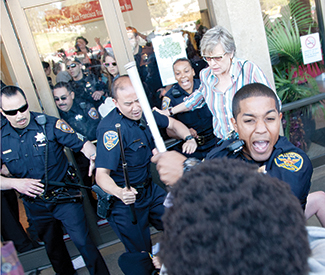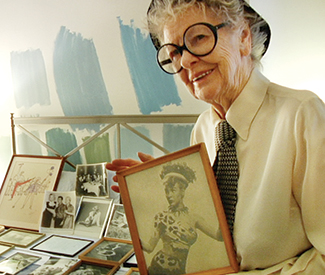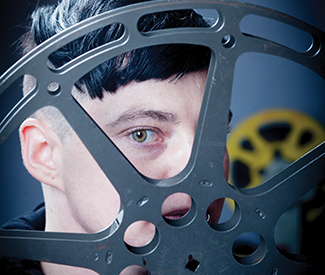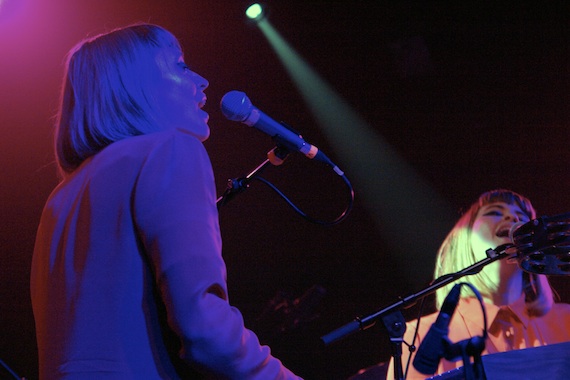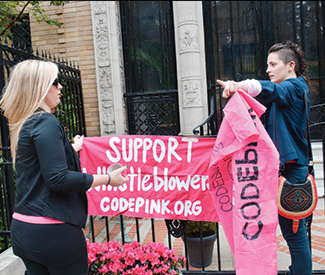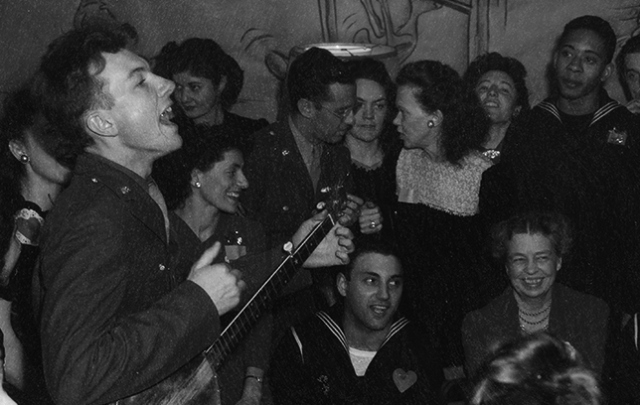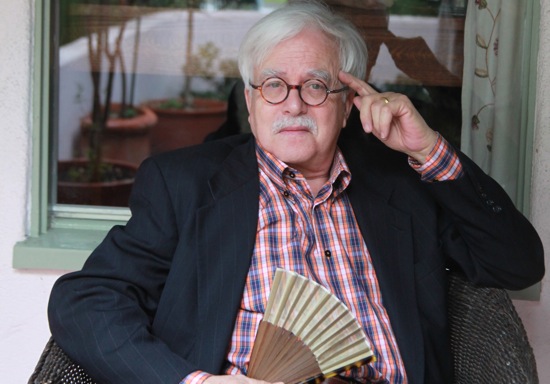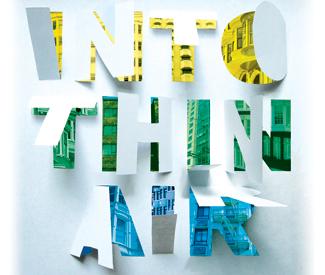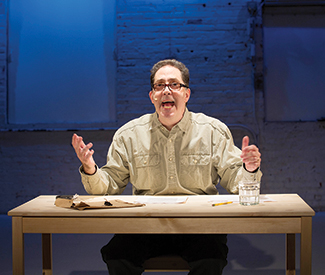WEDNESDAY 5
ROCK
Boom Boom Room: 1601 Fillmore, San Francisco. “The Larkade,” w/ Major Powers & The Lo-Fi Symphony, Rachel Lark, JK47, 9:30pm, free.
Bottom of the Hill: 1233 17th St., San Francisco. Together Pangea, Mozes & The Firstborn, Burning Curtains, 9pm, $10.
El Rio: 3158 Mission, San Francisco. Meat Market, Yi, Cop Out, 9pm, $7.
Elbo Room: 647 Valencia, San Francisco. We Are the Men, Bearcubbin, Face Tat, Van Wave, 9pm, $7.
Hemlock Tavern: 1131 Polk, San Francisco. Personal & The Pizzas, plus free Escape from New York pizza (while supplies last), 9pm, free.
The Independent: 628 Divisadero, San Francisco. The Mowgli’s, Tumbleweed Wanderers, Cocktails, 8pm, free with RSVP.
The Knockout: 3223 Mission, San Francisco. Modern Man, Paint the Trees White, Joseph Childress, 9:30pm, $6.
Milk Bar: 1840 Haight, San Francisco. Thufoxxtrots, Jam, The Cushion Theory, The Twitches, 8pm, $5.
Neck of the Woods: 406 Clement, San Francisco. The Pizza Underground, Windham Flat, Toby Goodshank, 6 & 9pm, $10-$15.
Yoshi’s San Francisco: 1330 Fillmore, San Francisco. Commander Cody & His Lost Planet Airmen, 8pm, $21-$25.
DANCE
111 Minna Gallery: 111 Minna, San Francisco. “Qoöl,” w/ DJs Ruchir, Alex Blackstock, Petko Nikolov, Spesh, Dan Sherman, and Will Spencer, 5-10pm, $5.
Beaux: 2344 Market, San Francisco. “BroMance: A Night Out for the Fellas,” 9pm, free.
The Cafe: 2369 Market, San Francisco. “Sticky Wednesdays,” w/ DJ Mark Andrus, 8pm, free.
Cat Club: 1190 Folsom, San Francisco. “Bondage A Go Go,” w/ DJs Damon, Tomas Diablo, & guests, 9:30pm, $5-$10.
Club X: 715 Harrison, San Francisco. “Electro Pop Rocks: Blood, Sweat, and Bass,” 18+ dance night with Downlink, Dieselboy, Ajapai, more, 9pm
F8: 1192 Folsom, San Francisco. “Housepitality,” w/ Jay Tripwire, Andrew Phelan, Stay Deep, Dr. Rek, Skyler Mendoza, 9pm, $5-$10.
Infusion Lounge: 124 Ellis, San Francisco. “Indulgence,” 10pm
Lookout: 3600 16th St., San Francisco. “What?,” w/ resident DJ Tisdale and guests, 7pm, free.
Madrone Art Bar: 500 Divisadero, San Francisco. “Rock the Spot,” 9pm, free.
MatrixFillmore: 3138 Fillmore, San Francisco. “Reload,” w/ DJ Big Bad Bruce, 10pm, free.
Q Bar: 456 Castro, San Francisco. “Booty Call,” w/ Juanita More, Joshua J, guests, 9pm, $3.
HIP-HOP
Neck of the Woods: 406 Clement, San Francisco. “Over the Hump,” w/ Children of the Funk, 10pm, free.
Skylark Bar: 3089 16th St., San Francisco. “Mixtape Wednesday,” w/ resident DJs Strategy, Junot, Herb Digs, & guests, 9pm, $5.
ACOUSTIC
Cafe Divine: 1600 Stockton, San Francisco. Craig Ventresco & Meredith Axelrod, 7pm, free.
The Chapel: 777 Valencia, San Francisco. A Salute to John Fahey in Honor of His 75th Birthday, w/ Sean Smith, Chuck Johnson, Henry Kaiser, Dibson Hoffweiler, Andrew Weathers, Adam Snider, Danny Paul Grody, Richard Osborn, 9pm, $12.
Hotel Utah: 500 Fourth St., San Francisco. Chris Trapper, Korby Lenker, 8pm, $15.
Plough & Stars: 116 Clement, San Francisco. Jeanie & Chuck’s Bluegrass Country Jam, First Wednesday of every month, 9pm, free.
JAZZ
Amnesia: 853 Valencia, San Francisco. Gaucho, Eric Garland’s Jazz Session, The Amnesiacs, 7pm, free.
Balancoire: 2565 Mission St., San Francisco. “Cat’s Corner,” 9pm, $10.
Burritt Room: 417 Stockton St., San Francisco. Terry Disley’s Rocking Jazz Trio, 6pm, free.
Cigar Bar & Grill: 850 Montgomery, San Francisco. Afro-Cuban Jazz Cartel, 8pm
Club Deluxe: 1511 Haight, San Francisco. Patrick Wolff Quartet, 9pm, free.
Jazz Bistro at Les Joulins: 44 Ellis, San Francisco. Charles Unger Experience, 7:30pm, free.
Le Colonial: 20 Cosmo, San Francisco. The Cosmo Alleycats featuring Ms. Emily Wade Adams, 7pm, free.
Pier 23 Cafe: Pier 23, San Francisco. Ned Boynton & Friends, 6pm, free.
Top of the Mark: One Nob Hill, 999 California, San Francisco. Ricardo Scales, Wednesdays, 6:30-11:30pm, $5.
Zingari: 501 Post, San Francisco. Anne O’Brien, First Wednesday of every month, 7:30pm, free.
INTERNATIONAL
Bissap Baobab: 3372 19th St., San Francisco. “Baobab!,” timba dance party with DJ WaltDigz, 10pm, $5.
Cafe Cocomo: 650 Indiana, San Francisco. “Bachatalicious,” w/ DJs Good Sho & Rodney, 7pm, $5-$10.
Make-Out Room: 3225 22nd St., San Francisco. “Frigo-Bar,” First Wednesday of every month, 8pm, free.
Pachamama Restaurant: 1630 Powell, San Francisco. Cafe Latino Americano, 8pm, $12.
BLUES
Biscuits and Blues: 401 Mason, San Francisco. Bob Margolin & Bob Corritore, 7:30 & 9:30pm, $20.
EXPERIMENTAL
Center for New Music: 55 Taylor, San Francisco. Sten Sandell with Gino Robair, 7:30pm, $10-$15.
Meridian Gallery: 535 Powell, San Francisco. Xo Xinh, Van-Anh Vanessa Vo, and Chris Brown, 7:30pm, $10.
SOUL
Monarch: 101 Sixth St., San Francisco. “Color Me Badd,” coloring books and R&B jams with Matt Haze, DJ Alarm, Broke-Ass Stuart, guests, Wednesdays, 5:30-9:30pm, free.
THURSDAY 6
ROCK
111 Minna Gallery: 111 Minna, San Francisco. RubberSideDown, Chris James & The Showdowns, Etro Canova, 7pm, free/donation.
Bottom of the Hill: 1233 17th St., San Francisco. Eyes on the Shore, Sunrunners, Dogcatcher, 9pm, $10.
Brick & Mortar Music Hall: 1710 Mission, San Francisco. Mirah, AgesandAges, M. Lockwood Porter, 9pm, $12-$15.
The Chapel: 777 Valencia, San Francisco. Arthur Beatrice, 9pm, $12-$14.
DNA Lounge: 375 11th St., San Francisco. The Vile Augury, Limnus, Roadside Memorial, Loveless Love, Mr. Smith, 8pm, $10 advance.
El Rio: 3158 Mission, San Francisco. Year of the Fist, Money for Rope, Muñecas, 8pm, $5.
Hemlock Tavern: 1131 Polk, San Francisco. Yogurt Brain, Divers, Nasty Christmas, 8:30pm, $6.
Rickshaw Stop: 155 Fell, San Francisco. “Popscene,” w/ Glasvegas, 10pm, $15-$17.
S.F. Eagle: 398 12th St., San Francisco. Slough Feg, Wild Eyes, Older Sun, 9pm, $8.
SFSU Campus, Cesar Chavez Student Center: 1650 Holloway, San Francisco. Useless Eaters, The Sweethearts, Scraper, Mane, 6pm, free.
DANCE
1015 Folsom: 1015 Folsom, San Francisco. Stwo, The Whooligan, Mikos Da Gawd, DJ Dials, Chad Salty, 9pm, $10 (free before 11pm with RSVP).
Abbey Tavern: 4100 Geary, San Francisco. DJ Schrobi-Girl, 10pm, free.
Audio Discotech: 316 11th St., San Francisco. “Common Ground,” w/ Shur-i-kan, Greg Yuen, Dino Velvet, Fil Latorre, Joey Alaniz, 9pm, $5-$10.
Aunt Charlie’s Lounge: 133 Turk, San Francisco. “Tubesteak Connection,” w/ DJ Bus Station John, 9pm, $5-$7.
Beaux: 2344 Market, San Francisco. “Men at Twerk,” 9pm, free.
The Cafe: 2369 Market, San Francisco. “¡Pan Dulce!,” 9pm, $5.
Cat Club: 1190 Folsom, San Francisco. “Throwback Thursdays,” ‘80s night with DJs Damon, Steve Washington, Dangerous Dan, and guests, 9pm, $6 (free before 9:30pm).
The Cellar: 685 Sutter, San Francisco. “XO,” w/ DJs Astro & Rose, 10pm, $5.
Club X: 715 Harrison, San Francisco. “The Crib,” 9:30pm, $10, 18+.
DNA Lounge: 375 11th St., San Francisco. Sound Remedy, Clark Kent, 8pm, $12-$15.
Elbo Room: 647 Valencia, San Francisco. “Afrolicious,” w/ DJs Pleasuremaker, Señor Oz, and guests, 9:30pm, $5-$8.
F8: 1192 Folsom, San Francisco. “Beat Church,” w/ resident DJs Neptune & Kitty-D, First Thursday of every month, 10pm, $10.
Infusion Lounge: 124 Ellis, San Francisco. “I Love Thursdays,” 10pm, $10.
Madrone Art Bar: 500 Divisadero, San Francisco. “Night Fever,” 9pm, $5 after 10pm
Q Bar: 456 Castro, San Francisco. “Throwback Thursday,” w/ DJ Jay-R, 9pm, free.
Raven: 1151 Folsom, San Francisco. “1999,” w/ VJ Mark Andrus, 8pm, free.
Ruby Skye: 420 Mason, San Francisco. “Awakening,” w/ Felix Cartal, 9pm, $15-$20 advance.
Underground SF: 424 Haight, San Francisco. “Bubble,” 10pm, free.
Vessel: 85 Campton, San Francisco. “Base: Local,” w/ Bardia F, ThuyVu, Mac Vaughn, John Kaberna, Lexel, 10pm, free with RSVP.
HIP-HOP
Eastside West: 3154 Fillmore, San Francisco. “Throwback Thursdays,” w/ DJ Madison, 9pm, free.
John Colins: 138 Minna, San Francisco. “Rewind,” w/ DJ J.W. Sounds, First Thursday of every month, 10pm, free.
Skylark Bar: 3089 16th St., San Francisco. “Peaches,” w/ lady DJs DeeAndroid, Lady Fingaz, That Girl, Umami, Inkfat, and Andre, 10pm, free.
Slim’s: 333 11th St., San Francisco. Aer, RDGLDGRN, New Beat Fund, 8pm, $17.
ACOUSTIC
Amnesia: 853 Valencia, San Francisco. Misisipi Mike & The Midnight Gamblers, First Thursday of every month, 9pm
Atlas Cafe: 3049 20th St., San Francisco. The Bogues, 8pm, free.
Bazaar Cafe: 5927 California, San Francisco. Acoustic Open Mic, 7pm
Hotel Utah: 500 Fourth St., San Francisco. Songwriters in the Round with Heather Combs, Kelly McFarling, Eoin Harrington, Brad Brooks, 8pm, $8.
The Independent: 628 Divisadero, San Francisco. Agnes Obel, 8pm, sold out.
The Lost Church: 65 Capp, San Francisco. Jeff Conley & Elena de da Garza, Brandon Eardley, 8pm, $10.
Milk Bar: 1840 Haight, San Francisco. S.F. Acoustic Sessions, w/ Leila Motaei, Scarth Locke, Jeff Desira, 7:30pm, free.
Musicians Union Local 6: 116 Ninth St., San Francisco. San Francisco Singer-Songwriters’ Workshop, hosted by Robin Yukiko, First Thursday of every month, 6:30pm, $25 (free for AFM members).
Plough & Stars: 116 Clement, San Francisco. The Shannon Céilí Band, First Thursday of every month, 9pm, free.
JAZZ
Blush! Wine Bar: 476 Castro, San Francisco. Doug Martin’s Avatar Ensemble, 7:30pm, free.
Cigar Bar & Grill: 850 Montgomery, San Francisco. Jimmy Grant Quartet, First Thursday of every month, 8pm, free.
Feinstein’s at the Nikko: 222 Mason, San Francisco. Paula West, 8pm, $35-$50.
Jazz Bistro at Les Joulins: 44 Ellis, San Francisco. Eugene Pliner Quartet with Tod Dickow, First and Third Thursday of every month, 7:30pm, free.
Le Colonial: 20 Cosmo, San Francisco. Steve Lucky & The Rhumba Bums, 7:30pm
Pier 23 Cafe: Pier 23, San Francisco. Judy Hall Trio, 7pm, free.
The Royal Cuckoo: 3202 Mission, San Francisco. Charlie Siebert & Chris Siebert, 7:30pm, free.
Savanna Jazz Club: 2937 Mission, San Francisco. Savanna Jazz Jam with David Byrd, 7pm, $5.
Top of the Mark: One Nob Hill, 999 California, San Francisco. Stompy Jones, 7:30pm, $10.
Zingari: 501 Post, San Francisco. Barbara Ochoa, 7:30pm, free.
INTERNATIONAL
Bissap Baobab: 3372 19th St., San Francisco. “Pa’Lante!,” w/ Juan G, El Kool Kyle, Mr. Lucky, 10pm, $5.
Pachamama Restaurant: 1630 Powell, San Francisco. “Jueves Flamencos,” 8pm, free.
Sheba Piano Lounge: 1419 Fillmore, San Francisco. Gary Flores & Descarga Caliente, 8pm
Verdi Club: 2424 Mariposa, San Francisco. The Verdi Club Milonga, w/ Christy Coté, DJ Emilio Flores, guests, 9pm, $10-$15.
REGGAE
Neck of the Woods: 406 Clement, San Francisco. Maoli, Mango Kingz, on the upstairs stage, 9pm, $12-$15.
Pissed Off Pete’s: 4528 Mission St., San Francisco. Reggae Thursdays, w/ resident DJ Jah Yzer, 9pm, free.
BLUES
50 Mason Social House: 50 Mason, San Francisco. Bill Phillippe, 5:30pm, free.
Biscuits and Blues: 401 Mason, San Francisco. Tad Robinson, 7:30 & 9:30pm, $20.
The Saloon: 1232 Grant, San Francisco. Chris Ford, First Thursday of every month, 4pm
SFJAZZ Center: 205 Franklin, San Francisco. Lavay Smith & Her Red Hot Skillet Lickers, playing the music of Bessie Smith (in the Joe Henderson Lab), 7 & 8:30pm, $30.
COUNTRY
The Parlor: 2801 Leavenworth, San Francisco. “Twang Honky Tonk & Country Jamboree,” w/ DJ Little Red Rodeo, 7pm, free.
EXPERIMENTAL
The Luggage Store: 1007 Market, San Francisco. Power Stations, Conan the Barbiturate, 8pm, $6-$10.
SOUL
Boom Boom Room: 1601 Fillmore, San Francisco. West Grand Boulevard, 9:30pm, $5.
Yoshi’s San Francisco: 1330 Fillmore, San Francisco. Teena Marie Birthday Tribute with Ashling “Biscuit” Cole, 8pm, $19-$23.
FRIDAY 7
ROCK
Boom Boom Room: 1601 Fillmore, San Francisco. Chum, 9:30pm, $12-$15.
Bottom of the Hill: 1233 17th St., San Francisco. Scale the Summit, The Ocean, The Atlas Moth, Silver Snakes, DJ Rob Metal, 8pm, $12-$14.
Brick & Mortar Music Hall: 1710 Mission, San Francisco. Gripin, Twenty7, 9pm, $30-$40.
The Chapel: 777 Valencia, San Francisco. Black Cobra Vipers, Jefferititi’s Nile, Sister Chief, 9pm, $12.
DNA Lounge: 375 11th St., San Francisco. Fake Your Own Death, I Am Animal, In Letter Form, Cash for Gold, 8:30pm, $8-$10.
El Rio: 3158 Mission, San Francisco. Friday Live: Mary Ocher, DJ Emotions, 10pm, free.
Elbo Room: 647 Valencia, San Francisco. Glitter Wizard, Christian Mistress, Ovvl, 9:30pm, $8.
Hemlock Tavern: 1131 Polk, San Francisco. Donkee, Tiger Honey Pot, Majestic Beast, Manstration, 9pm, $6.
Hotel Utah: 500 Fourth St., San Francisco. Overland, Crash Landings, First Contact, Sean O’Brien & His Dirty Hands, 9pm, $10.
The Independent: 628 Divisadero, San Francisco. Gardens & Villa, Waterstrider, Reuben & The Dark, 9pm, $13-$15.
Milk Bar: 1840 Haight, San Francisco. Solids, Pup, Balms, 9pm, $8-$10.
Slim’s: 333 11th St., San Francisco. The Greening, Everyone Is Dirty, Sweet Chariot, 9pm, $14.
Thee Parkside: 1600 17th St., San Francisco. Heartsounds, The Mighty Fine, Point of View, The Business End, 9pm, $8.
DANCE
1015 Folsom: 1015 Folsom, San Francisco. MartyParty, Joker, Robot Koch, Nick Hook, Pumpkin, Nesta, Releece, Dov, Jocelyn, 10pm, $15 advance.
Amnesia: 853 Valencia, San Francisco. “Brass Tax,” w/ resident DJs JoeJoe, Ding Dong, Ernie Trevino, Mace, First Friday of every month, 10pm, $5.
Audio Discotech: 316 11th St., San Francisco. Umek, Ben Seagren, Dean Samaras, 9pm, $15 advance.
BeatBox: 314 11th St., San Francisco. “Pulse SF: 3-Year Anniversary,” w/ Ticon, Emok, Critical Choice, 10pm, $25-$30 advance.
Beaux: 2344 Market, San Francisco. “Manimal,” 9pm
The Cafe: 2369 Market, San Francisco. “Boy Bar,” w/ DJ Matt Consola, 9pm, $5.
Cat Club: 1190 Folsom, San Francisco. “Strangelove: A Tribute to Skinny Puppy,” w/ DJs Tomas Diablo, Daniel Skellington, Lexor, and Panic, 9:30pm, $7 ($3 before 10pm).
The Cellar: 685 Sutter, San Francisco. “F.T.S.: For the Story,” 10pm
The EndUp: 401 Sixth St., San Francisco. “Trade,” 10pm, free before midnight.
The Grand Nightclub: 520 Fourth St., San Francisco. “We Rock Fridays,” 9:30pm
Harlot: 46 Minna, San Francisco. DJ Spider, 9pm
Infusion Lounge: 124 Ellis, San Francisco. “Flight Fridays,” 10pm, $20.
Lookout: 3600 16th St., San Francisco. “HYSL: Handle Your Shit Lady,” 9pm, $3.
Madrone Art Bar: 500 Divisadero, San Francisco. “Dirty Rotten Dance Party,” w/ Kap10 Harris, Shane King, guests, First Friday of every month, 9pm, $5.
MatrixFillmore: 3138 Fillmore, San Francisco. “F-Style Fridays,” w/ DJ Jared-F, 9pm
Mezzanine: 444 Jessie, San Francisco. “Future Fridays,” w/ Posso, Non Sequitur, Erika K, Monika Santucci, 9pm, $10.
Monarch: 101 Sixth St., San Francisco. Bob Moses, DJ M3, Lisbona, 9:30pm, $15-$20.
Powerhouse: 1347 Folsom, San Francisco. “Nasty,” First Friday of every month, 10pm, $5.
Public Works: 161 Erie, San Francisco. “Direct to Earth,” w/ Barem, Troy Pierce, Brian Knarfield, Max Gardner (in the main room), 9pm, $13-$20; “Play It Cool,” w/ Hound Scales, Avalon Emerson, Derek Opperman, Matthew Favorites, Guillaume Galuz (in the OddJob Loft), 10pm, $10.
Q Bar: 456 Castro, San Francisco. “Pump: Worq It Out Fridays,” w/ resident DJ Christopher B, 9pm, $3.
Rickshaw Stop: 155 Fell, San Francisco. Rüfüs, Lemaitre, DJ Aaron Axelsen, 9:30pm, $15-$17.
Ruby Skye: 420 Mason, San Francisco. Quintino, 9pm, $20-$30 advance.
Slate Bar: 2925 16th St., San Francisco. “Haçeteria,” w/ New Jack, Greg M, Jason P, Smac, Tristes Tropiques, Nihar, 10pm, $5.
Temple: 540 Howard, San Francisco. “Boogaloo Bounce,” w/ Brother Board, D-Clan, Freefall, 10pm, $15.
Underground SF: 424 Haight, San Francisco. “Bionic,” 10pm, $5.
Vessel: 85 Campton, San Francisco. “Blitz,” w/ Revolvr, DJ MyKill, Shawn Steele, Keelan, 10pm, $10-$30.
Wish: 1539 Folsom, San Francisco. “Bridge the Gap,” w/ resident DJ Don Kainoa, Fridays, 6-10pm, free; “Depth,” w/ resident DJs Sharon Buck & Greg Yuen, First Friday of every month, 10pm, free.
HIP-HOP
EZ5: 682 Commercial, San Francisco. “Decompression,” Fridays, 5-9pm
Mighty: 119 Utah, San Francisco. “Where’d You Get Those?,” w/ Bobbito, Stretch Armstrong, DJ Shortkut, DJ Proof, 9pm, $15 advance.
Nickies: 466 Haight, San Francisco. “First Fridays,” w/ The Whooligan & Dion Decibels, First Friday of every month, 11pm, free.
Yoshi’s San Francisco: 1330 Fillmore, San Francisco. De La Soul, 8 & 10pm, $46.
ACOUSTIC
Bazaar Cafe: 5927 California, San Francisco. Vessna Scheff, 7pm
Dolores Park Cafe: 501 Dolores, San Francisco. Beryl Baker & Co., 7:30pm
The Lost Church: 65 Capp, San Francisco. Cotton Polly, David Sobel & The Toms, 8pm, $10.
Plough & Stars: 116 Clement, San Francisco. A Talent for Mischief, 9pm
Red Poppy Art House: 2698 Folsom, San Francisco. Squid Inc. with Carrie Katz, 7:30pm, $10-$15.
The Sports Basement: 610 Old Mason, San Francisco. “Breakfast with Enzo,” w/ Enzo Garcia, 10am, $5.
St. Cyprian’s Episcopal Church: 2097 Turk, San Francisco. First Fridays Song Circle, First Friday of every month, 7pm, $5-$10.
JAZZ
Atlas Cafe: 3049 20th St., San Francisco. Jazz at the Atlas, 7:30pm, free.
Beach Chalet Brewery & Restaurant: 1000 Great Highway, San Francisco. Johnny Smith, 8pm, free.
Bird & Beckett: 653 Chenery, San Francisco. Don Prell’s SeaBop Ensemble, First Friday of every month, 5:30pm, free.
Cafe Royale: 800 Post, San Francisco. Wrapped in Plastic, First Friday of every month, 9pm
Feinstein’s at the Nikko: 222 Mason, San Francisco. Paula West, 8pm, $35-$50.
Jazz Bistro at Les Joulins: 44 Ellis, San Francisco. Charles Unger Experience, 7:30pm, free.
The Palace Hotel: 2 New Montgomery, San Francisco. The Klipptones, 8pm, free.
Pier 23 Cafe: Pier 23, San Francisco. Hard Bop Collective, 8pm, free.
Savanna Jazz Club: 2937 Mission, San Francisco. Savanna Jazz Trio, 7pm, $8.
SFJAZZ Center: 205 Franklin, San Francisco. Lavay Smith & Her Red Hot Skillet Lickers, playing the music of Billie Holiday (in the Joe Henderson Lab), 7 & 8:30pm, $30.
Top of the Mark: One Nob Hill, 999 California, San Francisco. Black Market Jazz Orchestra, 9pm, $10.
Zingari: 501 Post, San Francisco. Joyce Grant, 8pm, free.
INTERNATIONAL
Bissap Baobab: 3372 19th St., San Francisco. “Paris-Dakar African Mix Coupe Decale,” 10pm, $5.
Cafe Cocomo: 650 Indiana, San Francisco. Taste Fridays, featuring local cuisine tastings, salsa bands, dance lessons, and more, 7:30pm, $15 (free entry to patio).
Cigar Bar & Grill: 850 Montgomery, San Francisco. Rumbaché, 10pm
City Hall: 1 Drive Carlton B. Goodlett, San Francisco. Gamelan Sekar Jaya, The Rotunda Dance Series opens its 2014 season with this free Balinese music and dance performance., noon, free.
Pachamama Restaurant: 1630 Powell, San Francisco. Cuban Night with Fito Reinoso, 7:30 & 9:15pm, $15-$18.
REGGAE
Gestalt Haus: 3159 16th St., San Francisco. “Music Like Dirt,” 7:30pm, free.
Showdown: 10 Sixth St., San Francisco. “How the West Was Won,” w/ Nowtime Sound, First Friday of every month, 10pm, free.
BLUES
Biscuits and Blues: 401 Mason, San Francisco. Tad Robinson, 7:30 & 10pm, $22.
Lou’s Fish Shack: 300 Jefferson, San Francisco. Little Wolf & The HellCats, 6pm
Tupelo: 1337 Green, San Francisco. Jinx Jones & The KingTones, First Friday of every month, 9pm
EXPERIMENTAL
Artists’ Television Access: 992 Valencia, San Francisco. Mission Eye & Ear #4, New experimental film and sound collaborations by Suki O’Kane & John Davis, Jason Hoopes & Azin Seraj, Marielle Jakobsons & Kirthi Nath, and more., 8pm, $7-$10.
FUNK
Amnesia: 853 Valencia, San Francisco. Swoop Unit, First Friday of every month, 6pm, $3-$5.
Make-Out Room: 3225 22nd St., San Francisco. “Loose Joints,” w/ DJs Centipede, Damon Bell, and Tom Thump, 10pm, $5-$10.
SOUL
Edinburgh Castle: 950 Geary, San Francisco. “Soul Crush,” w/ DJ Serious Leisure, 10pm, free.
The Knockout: 3223 Mission, San Francisco. “Oldies Night,” w/ DJs Primo, Daniel, Lost Cat, friends, First Friday of every month, 10pm, $5.
SATURDAY 8
ROCK
Bender’s: 806 S. Van Ness, San Francisco. Electric Funeral, Hell Fire, 10pm, $5.
Bottom of the Hill: 1233 17th St., San Francisco. The Ataris, Authority Zero, Drag the River, Versus the World, 8pm, sold out.
Brick & Mortar Music Hall: 1710 Mission, San Francisco. Dead Ghosts, Los Craters, Mujeres, Banshee Boardwalk, DJ Al Lover, 9pm, $8-$10.
The Chapel: 777 Valencia, San Francisco. JD Samson & MEN, Skip the Needle, People at Parties, 9pm, $16-$18.
El Rio: 3158 Mission, San Francisco. Kepi Ghoulie with Dog Party, Unko Atama, Pogo Ono, 10pm, $8.
Hemlock Tavern: 1131 Polk, San Francisco. The Librarians, Victory & Associates, Charmless, 9pm, $6.
The Knockout: 3223 Mission, San Francisco. Abrupt, Serpent Crown, Sciatica, Syzygz, 4pm, $6.
Milk Bar: 1840 Haight, San Francisco. Hungry Skinny, Ape Machine, The Missing Pieces, Strange Hotel, DJ Chad Stab, 9pm, $7.
Thee Parkside: 1600 17th St., San Francisco. Stomper 98, The Old Firm Casuals, Control, Custom Fit, 9pm, $15.
DANCE
Amnesia: 853 Valencia, San Francisco. Jonas Reinhardt, Pharaohs, Roche, ProFan DJs, 9pm, $10.
Audio Discotech: 316 11th St., San Francisco. Fur Coat, Pacific Disco, Papa Lu, 9:30pm, $5-$10 advance.
BeatBox: 314 11th St., San Francisco. Official S.F. White Party Palm Springs Kick Off Party, w/ DJs Chris Cox & Del Stamp, 10pm, $10-$20.
Beaux: 2344 Market, San Francisco. Official Clueless After Party, With Peaches Christ, Mahlae Balenciaga, and DJ Guy Ruben., 9pm, $3.
Cat Club: 1190 Folsom, San Francisco. “Club Gossip: Depeche Mode Night,” w/ DJs Damon, Shon, Low-Life, Melting Girl, and Daniel Skellington, 9pm, $5-$8 (free before 9:30pm).
DNA Lounge: 375 11th St., San Francisco. “Bootie S.F.,” w/ DJ BC, A+D, DJ Jimig, Smash-Up Derby, DJ Dcnstrct, more, 9pm, $10-$15.
Elbo Room: 647 Valencia, San Francisco. “Tormenta Tropical,” w/ Jah Wave, Mr. E, Oro11, Deejay Theory, 10pm, $10.
The EndUp: 401 Sixth St., San Francisco. “Eclectricity,” Second Saturday of every month, 10pm
F8: 1192 Folsom, San Francisco. HGMNY: A Celebration of International Women’s Day, Benefit for the Center for Young Women’s Development with Astronautica, SoSuperSam, Kittens, Smasheltooth, Jaqi Sparrow, Umami, and Pony P., 9pm, $10-$15 advance.
Harlot: 46 Minna, San Francisco. WhiteNoize, 9pm
The Hot Spot: 1414 Market, San Francisco. “Love Will Fix It,” w/ DJ Bus Station John, Second Saturday of every month, 10pm, $5.
Infusion Lounge: 124 Ellis, San Francisco. “One Way Ticket Saturdays,” w/ Eric D-Lux, Second Saturday of every month, 10pm, $20.
The Knockout: 3223 Mission, San Francisco. “Galaxy Radio,” w/ resident DJs Smac, Emils, Holly B, and guests, Second Saturday of every month, 9pm, free.
Lookout: 3600 16th St., San Francisco. “Bounce!,” 9pm, $3.
Madrone Art Bar: 500 Divisadero, San Francisco. “Music Video Night,” w/ DJs Satva & 4AM, Second Saturday of every month, 10pm, $5.
Mezzanine: 444 Jessie, San Francisco. “Lights Down Low,” w/ Four Tet, Natasha Kmeto, DJ Dials, Sleazemore, Richie Panic, 9pm, sold out.
Mighty: 119 Utah, San Francisco. “Salted,” w/ Colette, Fred Everything, Julius Papp, 10pm, $10-$15 advance.
Monarch: 101 Sixth St., San Francisco. “As You Like It + The Bunker,” w/ Voices from the Lake, Jason Kendig, Christina Chatfield, Carlos Souffront, Mossmoss, 9pm, $20-$25.
OMG: 43 Sixth St., San Francisco. “Fixup: Grime City Reunion,” 10pm, $5.
Public Works: 161 Erie, San Francisco. Burnal Equinox 2014: The Multiverse Outpost, 7pm, $15-$20.
Q Bar: 456 Castro, San Francisco. “Shoop!: The Janet Remix,” w/ DJs Tommy T & Bryan B, 9pm
Rickshaw Stop: 155 Fell, San Francisco. “Cockblock,” w/ DJs Kidd Sysko & Chelsea Starr, 10pm, $10.
Ruby Skye: 420 Mason, San Francisco. Audien, 9pm, $20 advance.
The Stud: 399 Ninth St., San Francisco. “Frolic,” w/ Raid Zero, Lycan Catt, Cohn Jonner, NeonBunny, 8pm, $8 ($4 in costume).
Temple: 540 Howard, San Francisco. Andy Caldwell, Lucas Med, Magnetic, Rich Era, 10pm, $20.
Vessel: 85 Campton, San Francisco. The Chainsmokers, John Beaver, 10pm
Wish: 1539 Folsom, San Francisco. “All Styles & Smiles,” w/ DJ Tom Thump, Second Saturday of every month, 10pm, free.
HIP-HOP
111 Minna Gallery: 111 Minna, San Francisco. “Back to the ‘90s,” Second Saturday of every month, 9:30pm, $10.
Double Dutch: 3192 16th St., San Francisco. “Cash IV Gold,” w/ DJs Kool Karlo, Roost Uno, and Sean G, Second Saturday of every month, 10pm, free.
John Colins: 138 Minna, San Francisco. “Frothin,” w/ resident DJ Matt Cali, Second Saturday of every month, 10pm
Showdown: 10 Sixth St., San Francisco. “The Shit Show,” w/ resident DJ Taurus Scott, Second Saturday of every month, 10pm, two for $5.
ACOUSTIC
Atlas Cafe: 3049 20th St., San Francisco. Craig Ventresco and/or Meredith Axelrod, Saturdays, 4-6pm, free.
Bazaar Cafe: 5927 California, San Francisco. Songwriters in the Round with Alex Jimenez, 7pm
Hotel Utah: 500 Fourth St., San Francisco. The Royal Oui, Tall Heights, Keyan Keihani, 9pm, $10.
Neck of the Woods: 406 Clement, San Francisco. Grow & Twine, Trebuchet, Travis Hayes, on the downstairs stage, 9pm, $8.
Pa’ina: 1865 Post, San Francisco. Jim “Kimo” West, 7pm, $10.
Plough & Stars: 116 Clement, San Francisco. “Americana Jukebox,” w/ One Grass Two Grass Red Grass Bluegrass, 9pm, $6-$10.
St. Cyprian’s Episcopal Church: 2097 Turk, San Francisco. Misner & Smith, Maurice Tani, Sound of Sirens, 7:30pm, $15-$18.
JAZZ
Center for New Music: 55 Taylor, San Francisco. Vardan Ovsepian, 8pm, $10-$15.
Cigar Bar & Grill: 850 Montgomery, San Francisco. Josh Jones Latin Jazz Ensemble, 10pm
Feinstein’s at the Nikko: 222 Mason, San Francisco. Paula West, 7 & 9:30pm, $35-$50.
Jazz Bistro at Les Joulins: 44 Ellis, San Francisco. Bill “Doc” Webster & Jazz Nostalgia, 7:30pm, free.
Savanna Jazz Club: 2937 Mission, San Francisco. Savanna Jazz Trio, 7pm, $8.
SFJAZZ Center: 205 Franklin, San Francisco. Lavay Smith & Her Red Hot Skillet Lickers, playing the music of Etta James (in the Joe Henderson Lab), 7 & 8:30pm, $30.
Sheba Piano Lounge: 1419 Fillmore, San Francisco. The Robert Stewart Experience, 9pm
INTERNATIONAL
1015 Folsom: 1015 Folsom, San Francisco. “Pura,” 9pm, $20.
Amoeba Music: 1855 Haight, San Francisco. Sila, 2pm, free.
Bissap Baobab: 3372 19th St., San Francisco. Misión Flamenca, Monthly live music and dance performances., Second Saturday of every month, 7:30pm “Paris-Dakar African Mix Coupe Decale,” 10pm, $5.
Make-Out Room: 3225 22nd St., San Francisco. “El SuperRitmo,” w/ DJs Roger Mas & El Kool Kyle, 10pm, $5 before 11pm
Pachamama Restaurant: 1630 Powell, San Francisco. Eddy Navia & Pachamama Band, 8pm, free.
Red Poppy Art House: 2698 Folsom, San Francisco. Bang Data, 7:30pm, $10-$20.
Space 550: 550 Barneveld, San Francisco. “Club Fuego,” 9:30pm
BLUES
Biscuits and Blues: 401 Mason, San Francisco. Sista Monica, 7:30 & 10pm, $24.
Lou’s Fish Shack: 300 Jefferson, San Francisco. Robert “Hollywood” Jenkins, 6pm
The Riptide: 3639 Taraval, San Francisco. G.G. Amos, 9:30pm, free.
The Saloon: 1232 Grant, San Francisco. Dave Workman, Second Saturday of every month, 4pm
FUNK
Boom Boom Room: 1601 Fillmore, San Francisco. The Humidors, Jordan & The Ritual, DJ K-Os, 9:30pm, $10 advance.
The Independent: 628 Divisadero, San Francisco. Dumpstaphunk, Katdelic, 9pm, $22-$25.
ROCKABILLY
Pier 23 Cafe: Pier 23, San Francisco. The Royal Deuces, 8pm, free.
Slim’s: 333 11th St., San Francisco. Kim Lenz & The Jaguars, The B-Stars, Secret Town, DJ Tanoa, 9pm, $15.
SOUL
Yoshi’s San Francisco: 1330 Fillmore, San Francisco. Chanté Moore, 8 & 10pm, $35.
SUNDAY 9
ROCK
Brick & Mortar Music Hall: 1710 Mission, San Francisco. Richie Ramone, He Who Cannot Be Named, Bite, The Unfortunate Bastard, 8pm, $12-$15.
DNA Lounge: 375 11th St., San Francisco. Scarlett Fever ‘14, Rett Syndrome benefit show with The Chop Tops, MoFo Party Band, The Memphis Murder Men, Lords of S.F., Stigma 13, more, 1pm, $15.
El Rio: 3158 Mission, San Francisco. Down & Outlaws, Mark Nelsen Band, The Parmesans, 8pm, $5.
Make-Out Room: 3225 22nd St., San Francisco. Sea Dramas, New Sun Company, 7:30pm, $8.
DANCE
Beaux: 2344 Market, San Francisco. “Full of Grace: A Weekly House Music Playground,” 9pm, free.
The Cellar: 685 Sutter, San Francisco. “Replay Sundays,” 9pm, free.
The Edge: 4149 18th St., San Francisco. “’80s at 8,” w/ DJ MC2, 8pm
Elbo Room: 647 Valencia, San Francisco. “Dub Mission,” w/ Mungo’s Hi Fi featuring Solo Banton, DJ Sep, 9pm, $12-$17.
The EndUp: 401 Sixth St., San Francisco. “T.Dance,” 6am-6pm; “The Rhythm Room,” Second Sunday of every month, 8pm
F8: 1192 Folsom, San Francisco. “Stamina,” w/ Drumsound & Bassline Smith, 10pm, free.
The Knockout: 3223 Mission, San Francisco. “Sweater Funk,” 10pm, free.
Lookout: 3600 16th St., San Francisco. “Jock,” Sundays, 3-8pm, $2.
MatrixFillmore: 3138 Fillmore, San Francisco. “Bounce,” w/ DJ Just, 10pm
Otis: 25 Maiden, San Francisco. “What’s the Werd?,” w/ resident DJs Nick Williams, Kevin Knapp, Maxwell Dub, and guests, 9pm, $5 (free before 11pm).
The Parlor: 2801 Leavenworth, San Francisco. “Sunday Sessions,” w/ DJ Marc deVasconcelos, 9pm, free.
Q Bar: 456 Castro, San Francisco. “Gigante,” 8pm, free.
Temple: 540 Howard, San Francisco. “Sunset Arcade: Mardi Gras Madness,” 18+ dance party & game night with Mt. Eden, Sound It Out, Harris Pilton, Russ Mack, Self Dustrukt, Saphyre, more, 8pm, $10-$20; “Sunset Arcade,” 18+ dance party & game night, 9pm, $10.
HIP-HOP
Boom Boom Room: 1601 Fillmore, San Francisco. “Return of the Cypher,” 9:30pm, free.
ACOUSTIC
Amnesia: 853 Valencia, San Francisco. Levi Strom, Matthew Hable, The Gospel Flats, 8pm, $8-$10.
Hemlock Tavern: 1131 Polk, San Francisco. David Novick, Matt Kivel, 8:30pm, $6.
Hotel Utah: 500 Fourth St., San Francisco. Maggie McClure, Jessica Campbell, Essence, Sara Beth Go, 8pm, $10.
The Lucky Horseshoe: 453 Cortland, San Francisco. Bernal Mountain Bluegrass Jam, 4pm, free; The Bernal Hillbillies, Second Sunday of every month, 8pm
Madrone Art Bar: 500 Divisadero, San Francisco. “Spike’s Mic Night,” Sundays, 4-8pm, free.
Milk Bar: 1840 Haight, San Francisco. Lonesome Locomotive, Rocket Frog Rodeo, Dusty Green Bones Band, 4pm, free.
St. Luke’s Episcopal Church: 1755 Clay, San Francisco. “Sunday Night Mic,” w/ Roem Baur, 5pm, free.
Tupelo: 1337 Green, San Francisco. “Twang Sundays,” w/ The Coburns, 7pm, free.
JAZZ
Chez Hanny: 1300 Silver, San Francisco. Calvin Keys Trio, 4pm, $20 suggested donation.
Feinstein’s at the Nikko: 222 Mason, San Francisco. Paula West, 7pm, $35-$50.
Jazz Bistro at Les Joulins: 44 Ellis, San Francisco. Bill “Doc” Webster & Jazz Nostalgia, 7:30pm, free.
Madrone Art Bar: 500 Divisadero, San Francisco. “Sunday Sessions,” 10pm, free.
Martuni’s: 4 Valencia, San Francisco. Madame Jo Trio, second Sunday of every month, 4-6pm, free.
Pier 23 Cafe: Pier 23, San Francisco. Gary Flores Ensemble, 5pm, free.
Revolution Cafe: 3248 22nd St., San Francisco. Jazz Revolution, 4pm, free/donation.
SFJAZZ Center: 205 Franklin, San Francisco. Lavay Smith & Her Red Hot Skillet Lickers, playing the music of Sarah Vaughan (in the Joe Henderson Lab), 5:30 & 7pm, $30.
Yoshi’s San Francisco: 1330 Fillmore, San Francisco. Kris Bowers Quintet featuring Julia Easterlin, Myele Manzanza Trio with Mark de Clive-Lowe & Ben Shepherd, 7pm, $17-$19.
Zingari: 501 Post, San Francisco. Carol Luckenbach, 7:30pm, free.
INTERNATIONAL
Atmosphere: 447 Broadway, San Francisco. “Hot Bachata Nights,” w/ DJ El Guapo, 5:30pm, $10-$20.
Bissap Baobab: 3372 19th St., San Francisco. “Brazil & Beyond,” 6:30pm, free.
El Rio: 3158 Mission, San Francisco. Salsa Sundays, Second and Fourth Sunday of every month, 3pm, $8-$10.
Thirsty Bear Brewing Company: 661 Howard, San Francisco. “The Flamenco Room,” 7:30 & 8:30pm
BLUES
Lou’s Fish Shack: 300 Jefferson, San Francisco. Sam Johnson, 4pm
The Saloon: 1232 Grant, San Francisco. Blues Power, 4pm; The Door Slammers, Second Sunday of every month, 9:30pm
Sheba Piano Lounge: 1419 Fillmore, San Francisco. Bohemian Knuckleboogie, 8pm, free.
Swig: 571 Geary, San Francisco. Sunday Blues Jam with Ed Ivey, 9pm
COUNTRY
The Riptide: 3639 Taraval, San Francisco. Joe Goldmark & The Seducers, Second Sunday of every month, 7:30pm, free.
SOUL
Delirium Cocktails: 3139 16th St., San Francisco. “Heart & Soul,” w/ DJ Lovely Lesage, 10pm, free.
MONDAY 10
ROCK
Hemlock Tavern: 1131 Polk, San Francisco. Books on Fate, Night Train, City of Women, 6pm, $5.
Milk Bar: 1840 Haight, San Francisco. Lemme Adams, Red Ribbon, Charm, 9pm, free.
DANCE
DNA Lounge: 375 11th St., San Francisco. “Death Guild,” 18+ dance party with DJs Decay, Joe Radio, Melting Girl, & guests, 9:30pm, $3-$5.
Q Bar: 456 Castro, San Francisco. “Wanted,” w/ DJs Key&Kite and Richie Panic, 9pm, free.
Underground SF: 424 Haight, San Francisco. “Vienetta Discotheque,” w/ DJs Stanley Frank and Robert Jeffrey, 10pm, free.
ACOUSTIC
Amnesia: 853 Valencia, San Francisco. The Pick Bluegrass Jam, Second Monday of every month, 6pm, free; Toshio Hirano, Second Monday of every month, 9pm, free.
Brick & Mortar Music Hall: 1710 Mission, San Francisco. Scott Barkan, Muncie, The Old Way, 9pm, $5.
The Chapel: 777 Valencia, San Francisco. Diane Cluck, Sondra Sun-Odeon, 8pm, $13-$15.
The Chieftain: 198 Fifth St., San Francisco. The Wrenboys, 7pm, free.
Elbo Room: 647 Valencia, San Francisco. The Riverbreaks, Evan & The Eccentrics, 9pm, $8.
Fiddler’s Green: 1333 Columbus, San Francisco. Terry Savastano, 9:30pm, free/donation.
Hotel Utah: 500 Fourth St., San Francisco. Open Mic with Brendan Getzell, 8pm, free.
Osteria: 3277 Sacramento, San Francisco. “Acoustic Bistro,” 7pm, free.
The Saloon: 1232 Grant, San Francisco. Peter Lindman, 4pm
JAZZ
Jazz Bistro at Les Joulins: 44 Ellis, San Francisco. Eugene Pliner Quartet with Tod Dickow, 7:30pm, free.
Le Colonial: 20 Cosmo, San Francisco. Le Jazz Hot, 7pm, free.
Sheba Piano Lounge: 1419 Fillmore, San Francisco. City Jazz Instrumental Jam Session, 8pm
Zingari: 501 Post, San Francisco. Nora Maki, 7:30pm, free.
REGGAE
Skylark Bar: 3089 16th St., San Francisco. “Skylarking,” w/ I&I Vibration, 10pm, free.
BLUES
The Saloon: 1232 Grant, San Francisco. The Bachelors, 9:30pm
EXPERIMENTAL
Center for New Music: 55 Taylor, San Francisco. Thom Blum: Soundscraper, 8pm, $10-$15.
SOUL
Madrone Art Bar: 500 Divisadero, San Francisco. “M.O.M. (Motown on Mondays),” w/ DJ Gordo Cabeza & Timoteo Gigante, 8pm, free.
TUESDAY 11
ROCK
Amnesia: 853 Valencia, San Francisco. Cellar Doors, Cool Ghouls, 9:15pm continues through March 25, $7-$10.
Bottom of the Hill: 1233 17th St., San Francisco. Little Sister, Apogee Sound Club, The Secret Secretaries, 8:30pm, $8.
El Rio: 3158 Mission, San Francisco. Alone in the Universe, Miss Massive Snowflake, Lucid Optics, 7pm, $5.
Hemlock Tavern: 1131 Polk, San Francisco. Lo Cash Ninjas, Jokes for Feelings, Spawn Atomic, Black Dream, 9pm, $5.
The Knockout: 3223 Mission, San Francisco. Shannon & The Clams, Marriage & Cancer, Mane, DJ Hang The, 9:30pm, $8.
DANCE
Aunt Charlie’s Lounge: 133 Turk, San Francisco. “High Fantasy,” w/ DJ Viv, Myles Cooper, & guests, 10pm, $2.
Harlot: 46 Minna, San Francisco. “Tutu Tuesday,” w/ resident DJ Atish, Second Tuesday of every month, 9pm, $7 ($2 in a tutu before 11pm).
Monarch: 101 Sixth St., San Francisco. “Soundpieces,” 10pm, free-$10.
Q Bar: 456 Castro, San Francisco. “Switch,” w/ DJs Jenna Riot & Andre, 9pm, $3.
Underground SF: 424 Haight, San Francisco. “Shelter,” 10pm, free.
Wish: 1539 Folsom, San Francisco. “Tight,” w/ resident DJs Michael May & Lito, 8pm, free.
HIP-HOP
Double Dutch: 3192 16th St., San Francisco. “Takin’ It Back Tuesdays,” w/ DJs Mr. Murdock & Roman Nunez, Second Tuesday of every month, 10pm, free.
ACOUSTIC
Bazaar Cafe: 5927 California, San Francisco. Songwriter in Residence: Lonnie Lazar, 7pm continues through March 25.
Hotel Utah: 500 Fourth St., San Francisco. Amy Obenski, ArtemesiaBlack, David Colón, 8pm, $7.
Plough & Stars: 116 Clement, San Francisco. Seisiún with Barry O’Connell & Vinnie Cronin, 9pm
Rickshaw Stop: 155 Fell, San Francisco. Scott H. Biram, Larry & His Flask, Whiskey Shivers, Tom VandenAvond, 7:30pm, $13.
JAZZ
Beach Chalet Brewery & Restaurant: 1000 Great Highway, San Francisco. Gerry Grosz Jazz Jam, 7pm
Blush! Wine Bar: 476 Castro, San Francisco. Kally Price & Rob Reich, 7pm, free.
Burritt Room: 417 Stockton St., San Francisco. Terry Disley’s Rocking Jazz Trio, 6pm, free.
Cafe Divine: 1600 Stockton, San Francisco. Chris Amberger, 7pm
Jazz Bistro at Les Joulins: 44 Ellis, San Francisco. Clifford Lamb, Mel Butts, and Friends, 7:30pm, free.
Le Colonial: 20 Cosmo, San Francisco. Lavay Smith & Her Red Hot Skillet Lickers, 7pm
Revolution Cafe: 3248 22nd St., San Francisco. West Side Jazz Club, 5pm, free.
Tupelo: 1337 Green, San Francisco. Mal Sharpe’s Big Money in Jazz Band, 6pm
Verdi Club: 2424 Mariposa, San Francisco. “Tuesday Night Jump,” w/ Stompy Jones, 9pm, $10-$12.
Wine Kitchen: 507 Divisadero St., San Francisco. Hot Club Pacific, 7:30pm
Yoshi’s San Francisco: 1330 Fillmore, San Francisco. Tommy Igoe Big Band, 8pm, $22.
Zingari: 501 Post, San Francisco. Riley Bandy, 7:30pm, free.
INTERNATIONAL
Brick & Mortar Music Hall: 1710 Mission, San Francisco. Gautam Tejas Ganeshan, Classical Revolution, Cash Pony, 7:30pm, $7-$10.
Cafe Cocomo: 650 Indiana, San Francisco. Salsa Tuesday, w/ DJs Good Sho & El de la Clave, 8:30pm, $10.
The Cosmo Bar & Lounge: 440 Broadway, San Francisco. Conga Tuesdays, 8pm, $7-$10.
F8: 1192 Folsom, San Francisco. “Underground Nomads,” w/ rotating resident DJs Amar, Sep, and Dulce Vita, plus guests, 9pm, $5 (free before 9:30pm).
REGGAE
Milk Bar: 1840 Haight, San Francisco. “Bless Up,” w/ Jah Warrior Shelter Hi-Fi, 10pm
BLUES
Biscuits and Blues: 401 Mason, San Francisco. Ron Thompson & The Resistors, 7:30 & 9:30pm, $15.
EXPERIMENTAL
Center for New Music: 55 Taylor, San Francisco. sfSoundSalonSeries, w/ Joan La Barbara, 7:49pm, $10-$15.
SOUL
Make-Out Room: 3225 22nd St., San Francisco. “Lost & Found,” w/ DJs Primo, Lucky, and guests, 9:30pm, free. 2

